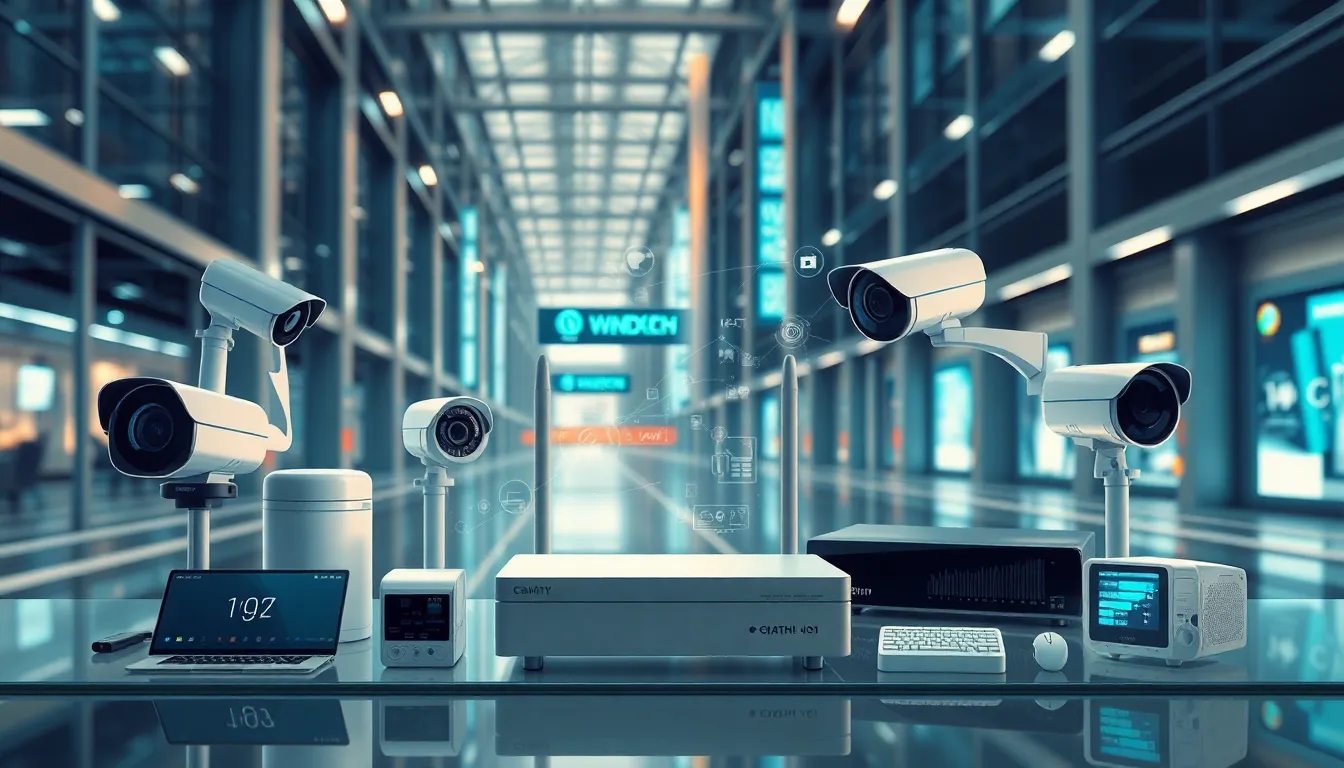In a world where data is generated at lightning speed, Edge AI is revolutionizing how we process information. By bringing artificial intelligence closer to the source of data, it enables real-time decision-making and reduces latency, making it a game-changer for various industries. From smart cities to autonomous vehicles, Edge AI empowers devices to analyze and act on data instantly, enhancing efficiency and user experiences.
As organizations increasingly rely on IoT devices, the need for intelligent, decentralized computing has never been more critical. Edge AI not only alleviates bandwidth concerns but also bolsters privacy and security by keeping sensitive data local. This shift towards intelligent edge computing is set to redefine technological landscapes, paving the way for innovations that were once thought impossible.
Table of Contents
ToggleOverview of Edge AI
Edge AI represents a paradigm shift in how artificial intelligence processes data. By deploying AI algorithms on edge devices, such as smartphones and IoT sensors, it enables immediate analysis and actions at the source. This architecture significantly reduces the distance data must travel, which enhances response times and minimizes latency.
Edge AI systems support various applications, including smart surveillance, industrial automation, and healthcare monitoring. In smart surveillance, for example, real-time video analysis allows for instant threat detection while preserving bandwidth by processing video locally. In industrial settings, predictive maintenance powered by Edge AI identifies potential equipment failures before breakdowns occur, enhancing operational efficiency.
Further, Edge AI strengthens data privacy and security by retaining sensitive information on local devices rather than transmitting it to centralized clouds. This localized processing reduces the risk of data breaches and mitigates compliance issues associated with data regulations.
As organizations increasingly rely on IoT devices, the demand for robust Edge AI solutions grows. These solutions not only provide faster and more reliable decision-making capabilities but also improve overall user experiences across industries.
Key Components of Edge AI

Edge AI comprises several critical components that facilitate its efficient operation. Among these components, edge devices and data processing systems play pivotal roles in delivering real-time insights and actions.
Edge Devices
Edge devices form the backbone of Edge AI by hosting AI algorithms and performing computations at the data source. Examples of these devices include:
- IoT Sensors: Collect environmental data and communicate it to other devices for analysis.
- Smart Cameras: Execute real-time video analytics to detect anomalies or threats.
- Gateways: Function as intermediaries, processing data from multiple edge devices and transmitting insights to centralized systems.
These devices enable immediate analysis and decision-making, significantly reducing response times in various applications, such as healthcare monitoring and autonomous vehicles.
Data Processing
Data processing in Edge AI occurs on the edge devices, ensuring timely and secure handling of data. Techniques include:
- Real-Time Analytics: Analyze incoming data streams for instant insights and actions, crucial for applications like smart traffic management.
- Machine Learning Models: Deploy edge-trained algorithms that adapt based on local data, improving prediction accuracy and relevance.
- Data Filtering: Reduce bandwidth usage by filtering out non-essential information before sending it to the cloud, enhancing efficiency and lowering latency.
These data processing strategies enhance operational efficiency while maintaining data privacy, as sensitive information remains local to the edge devices, minimizing exposure to external vulnerabilities.
Benefits of Edge AI
Edge AI offers numerous advantages that enhance performance and efficiency in various sectors. By enabling local data processing, it reduces response times and strengthens data privacy.
Reduced Latency
Reduced latency significantly enhances user experience. Edge AI processes data closer to the source, minimizing delays associated with sending data to centralized servers. For instance, in autonomous vehicles, quick processing of information from cameras and sensors allows for immediate decision-making, crucial for safety. In smart surveillance, real-time video analytics enable instant identification of threats, facilitating rapid responses. Lower latency promotes seamless interaction with applications, making tasks more efficient and effective.
Enhanced Privacy
Enhanced privacy becomes paramount in an increasingly data-driven landscape. Edge AI secures sensitive information by keeping it local, reducing exposure to external breaches. By analyzing data directly on devices like smartphones and IoT sensors, organizations mitigate risks linked to data transmission and storage at centralized locations. For example, in healthcare, patient data remains protected on local devices, ensuring compliance with regulations like HIPAA. This localized approach strengthens security measures, instilling greater confidence among users regarding data handling and protection.
Applications of Edge AI
Edge AI finds numerous applications across various sectors, enhancing efficiency and responsiveness by processing data closer to its source.
Smart Cities
Smart cities leverage Edge AI to manage urban resources efficiently. Intelligent traffic systems utilize real-time data to optimize traffic flow and reduce congestion. Smart lighting adjusts energy usage based on real-time pedestrian and vehicular activity. Environmental monitoring employs sensors to collect data on air quality and weather conditions, facilitating prompt responses to pollution or climate changes.
Healthcare
In healthcare, Edge AI plays a vital role in patient monitoring and diagnostics. Wearable devices analyze vital signs in real-time, alerting healthcare providers to concerning changes. Medical imaging applications process images locally, enabling instant analysis and reducing the time to diagnose conditions. Edge AI systems also support telehealth by providing secure, real-time communication between patients and providers, ensuring privacy and compliance with regulations.
Industrial Automation
Industrial automation benefits from Edge AI through predictive maintenance and automated quality control. IoT sensors monitor equipment conditions, analyzing data to predict potential failures before they occur, therefore reducing downtime. Quality control processes utilize computer vision to examine products on assembly lines, instantly identifying defects and ensuring high standards are maintained. This localized data processing enhances operational efficiency while minimizing reliance on cloud infrastructure.
Challenges and Limitations of Edge AI
Edge AI faces several challenges that impact its deployment and effectiveness. These include security concerns and connectivity issues that require attention for optimal performance.
Security Concerns
Security remains a primary challenge in Edge AI implementations. Edge devices often operate in less secure environments compared to centralized data centers, exposing them to potential cyberattacks. Devices like smart cameras and IoT sensors might store sensitive data locally, making them attractive targets for hackers. Consequently, vulnerabilities in device firmware and insufficient encryption can lead to data breaches and unauthorized access. Implementing robust security measures, such as encryption protocols and regular software updates, is critical in mitigating these risks.
Connectivity Issues
Connectivity presents another significant challenge for Edge AI systems. While processing data locally reduces latency, it often relies on stable network connections for updates and communication between devices. In areas with poor connectivity, real-time data processing can suffer, leading to delays or inaccuracies in decision-making. Additionally, inconsistent internet access may hinder the ability to aggregate insights from multiple edge devices. Ensuring reliable connectivity, through advancements in network technologies like 5G, is essential for Edge AI’s success and the seamless operation of interconnected systems.
Future of Edge AI
Edge AI is poised to expand rapidly, driven by advances in technology and increasing demand for real-time data processing. Predictions indicate that the global Edge AI market will reach approximately $6.72 billion by 2024, with a compound annual growth rate (CAGR) of 28.5% from 2020. Industries are leveraging Edge AI to enhance automation, improve efficiency, and foster innovation.
Applications will likely become more sophisticated, particularly in sectors such as healthcare, transportation, and manufacturing. In healthcare, wearable devices utilizing Edge AI will monitor vital signs in real time, delivering alerts for critical conditions swiftly. In transportation, autonomous vehicles equipped with Edge AI will analyze surroundings instantly, making decisions that enhance safety.
In manufacturing, predictive maintenance powered by Edge AI will reduce downtime. Machines will communicate performance data, enabling early detection of potential failures before they escalate. Such innovations will drive operational efficiency and lower maintenance costs significantly.
The growing reliance on 5G technology will also fuel Edge AI adoption. 5G networks offer higher speeds and lower latency, fostering seamless connections between edge devices. This connectivity will allow Edge AI systems to process data more effectively while maintaining real-time capabilities.
Security will remain a priority as Edge AI evolves. Implementing advanced cybersecurity measures, such as decentralized data encryption and robust authentication protocols, will mitigate risks associated with edge devices. Companies will prioritize building secure frameworks that protect sensitive data while harnessing AI’s potential.
Regulatory compliance will shape the development of Edge AI technologies. Organizations will adapt to evolving privacy laws and data protection regulations by ensuring Edge AI applications align with compliance standards. This alignment will not only safeguard user data but also enhance trust in Edge AI technologies.
The integration of Edge AI with other emerging technologies, such as blockchain and Internet of Things (IoT), will drive further innovation. Combining these technologies will enhance data integrity, improve transparency, and create new opportunities for businesses across various sectors.
Edge AI’s future presents numerous possibilities, emphasizing efficient data processing, enhanced automation, and stronger security measures. As industries adopt this transformative technology, the potential for groundbreaking advancements and improved operational capabilities will increase significantly.
Edge AI stands at the forefront of technological innovation transforming how data is processed and utilized. By bringing intelligence closer to data sources, it enhances real-time decision-making and addresses critical issues like latency and privacy. As industries increasingly adopt this paradigm, the potential for improved efficiency and security becomes evident.
The integration of Edge AI with emerging technologies will likely open new avenues for growth and innovation. Organizations that embrace this shift will not only enhance their operational capabilities but also foster greater trust among users regarding data handling. The future of Edge AI is bright and promises to redefine the landscape of data processing across multiple sectors.




